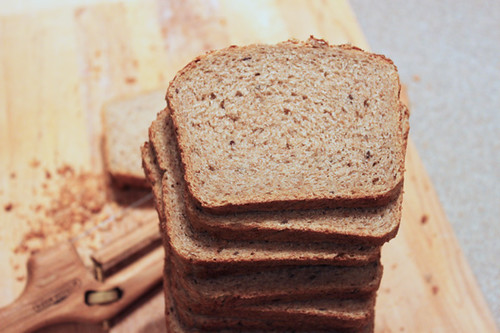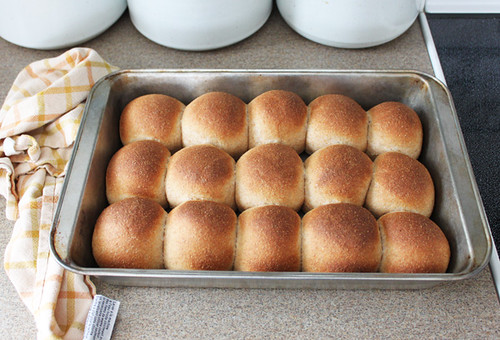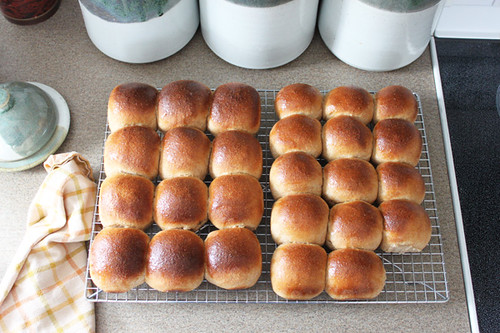This is what happens when one tries to make the Oatmeal Bread from the Laurel's Kitchen Bread Book on a day that turned out to be too busy to make bread!

The night before, I had cooked 1 1/3 cups of Roger's Porridge Oats* in 2 cups of boiling water, adding 1 Tbsp of salt once the porridge was off the heat. I left the porridge to cool overnight in a glass bowl covered with plastic wrap.
*Roger's Porridge Oats are a blend of rolled oats, oat bran, wheat bran and flax
In the morning, not as early as I'd hoped, I ground some fresh whole wheat flour and mixed up the dough as per the recipe. The flour was straight out of the grinder, still warm. I found I had to add more water than the recipe called for to make the dough come together. The dough was still extremely stiff, but because the recipe insisted that the dough would absorb moisture from the oatmeal as it was kneaded, I didn't add more.
Right after mixing, I unexpectedly had to leave the house for a couple of hours. I hadn't had time to knead the dough (by hand) for more than 2 minutes, and I never did add more water to soften it up. I put the stiff ball into a bowl, covered it with plastic wrap, and left it on the counter. The house temp was 17 degrees C.
When I got back a couple of hours later I only had a few minutes before I had to leave again. The dough had risen about one and a half times. I put the dough on a board, flattened it gently, folded it a couple of times, made a ball and put it back in the bowl. It was so stiff that there was no stretching and folding possible - just a patting out, then folding to the middle.
When I came home again 2 hours later, the dough had risen to about one and a half times again and it was almost supper time. I had no idea how to fix or amend the dough at this point, so I figured I'd get it ready for baking and see what happened. I divided the dough into two and kneaded each piece briefly. It tore pretty easily. It was still quite stiff. I don't know if that's what I should expect from 100% whole wheat loaves or if the dough does eventually get stretchy if it is handled properly. I let the two pieces rest for 15 minutes or so, then formed them into loaves and placed them into two loaf pans brushed with pan grease.
I put the bread to rise in the oven with the lights on and a pan of hot water. It had been sitting in a cold, dry house all day and I thought I'd finally give it some warmth. Once it was just over the edge of the pan, I brushed the loaves with warm milk and topped them with more porridge oats that had been soaked in milk for a few minutes. I removed the steam pan, turned the oven to 400F, and baked the loaves with the cold oven method for 45 minutes, turning the heat to 350 after 20 minutes or so.

The loaves never did rise very well, but the bread turned out very moist and flavourful - way better than I was expecting after having to abandon it for most of the day. It makes delicious toast.

Things I was left wondering:
- Should the dough have been softer? It was so stiff that kneading was a real chore.
- If I had kneaded it for more than the 2 minutes I had available, would it have ended up stretchy and gluteny and stopped tearing, or is that too much to expect from a whole grain dough?
- Did sitting all day help, or hinder, the dough?
- Could I have amended the dough after it sat all day, when I finally came home for the evening?
- Can the seeds in the oatmeal actually cut the gluten strands during kneading and ruin them? Should I use plain oats next time?
- What can you tell about my bread from looking at the crumb in the photo above? I don't know anything about "crumb" and that's what I find most intimidating about this site. Can you experienced bakers take one look at my sliced bread above and shudder and know everything I did wrong in a mere glance?










